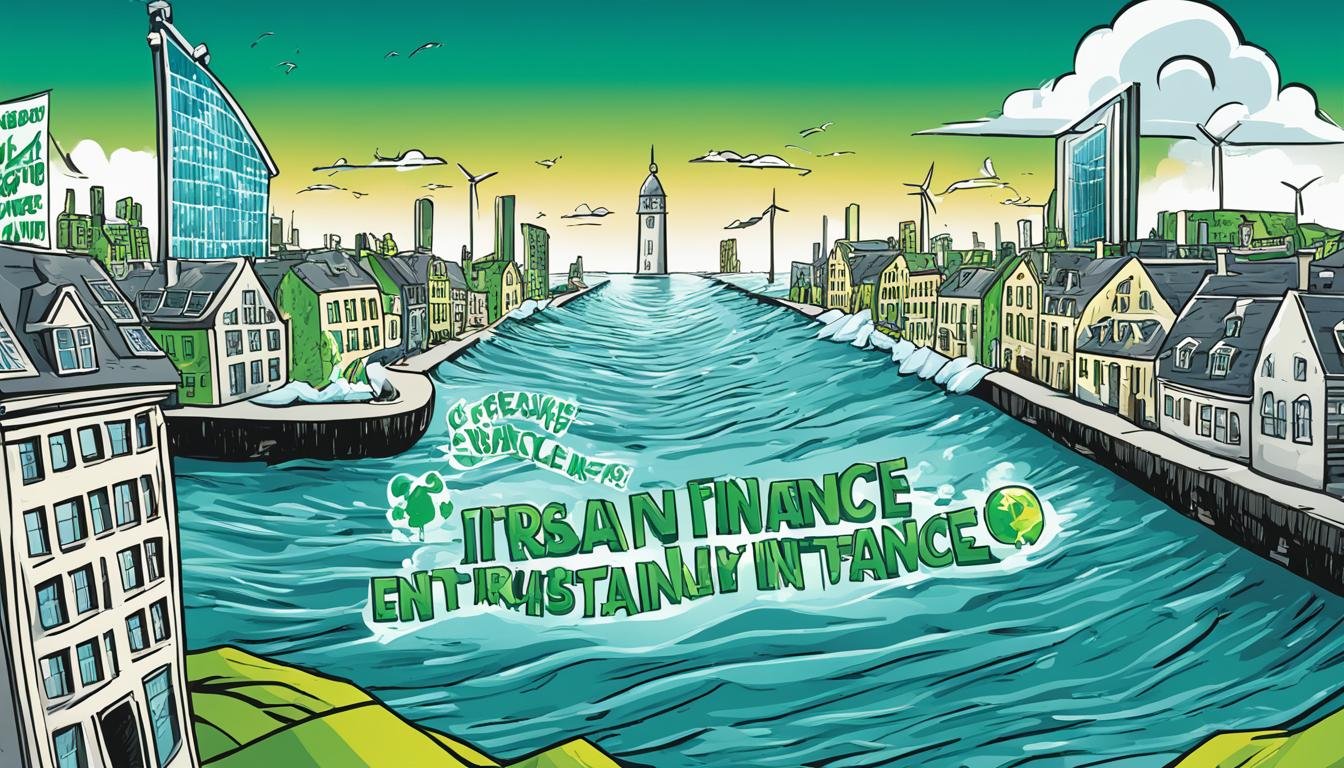Ireland’s Financial Services and Climate Change: Opportunities and Challenges
Ireland must become carbon neutral by 2050, a big task. It aims to cut greenhouse gas emissions by 51% by 2030. But, it’s on track for only a 29% cut, showing the big challenges it faces. Climate change is changing our world, affecting Ireland’s finance sector and economy a lot.
Climate change brings both chances and hurdles for finance. With more extreme weather and high costs for following rules, Ireland’s banks and financial groups need to change. They must use sustainable finance to meet environmental goals and grow the economy.
Understanding climate change’s effects is key for Ireland’s finance sector. Cutting greenhouse gases and managing risks well is vital for a sustainable economy.
Key Takeaways
- Ireland must achieve carbon neutrality by 2050, with aggressive emission reduction targets.
- The financial services sector faces significant challenges in adapting to evolving climate risks.
- Sustainable finance offers numerous opportunities for economic growth despite compliance costs.
- Effective climate risk management is crucial for ensuring the resilience of financial institutions.
- Public and private sectors must collaborate to achieve climate goals and support adaptation efforts.
- The urgency of addressing climate change includes proactive strategies that tackle both mitigation and adaptation.
Introduction to Climate Change in Ireland
Climate change is a big challenge for Ireland, with big changes in its weather. The average temperature has risen to 10.2 degrees Celsius over the last 20 years. By 2050, it could go up to 11 degrees Celsius, changing Ireland weather trends a lot.
Ireland just had its wettest decade in 300 years, showing how climate impact and increasing rainfall are making extreme weather more common. We need to work together, from politics to communities, to fight this change. Using science helps us know how to adapt and lessen the risks.
- Transformative change offers benefits for both people and nature.
- There is an urgent requirement to bridge the gap between ambition and action.
- Societal mobilization is necessary to address greenhouse gas emissions.
- Broader systemic transformations and shifts in development pathways are essential.
We must tackle the indirect causes of climate change and losing biodiversity to make good responses. Ireland is upping its climate finance, but focusing on tech might not be enough. We need a plan that fits with sustainable development to meet our climate goals.
Understanding the Impact of Climate Change on the Financial Sector
The financial sector in Ireland is facing big challenges because of climate change. Extreme weather events are happening more often, causing assets to lose value and insurance claims to go up. This leads to big financial risks and makes it hard for businesses to adapt.
Now, there’s a big push for companies to be open about how climate change affects them. A new framework is looking at 90 big institutions in the euro area to see how climate risks spread through the financial system. Sadly, only 5 of the 26 biggest banks and insurers in the euro area share how climate risks hit their finances.
Financial institutions need to change their plans to think more about climate change. Experts say they need to work on climate scenario analysis quickly. As people see the financial side of climate change, risk management teams are trying to add climate concerns to their financial plans.
Climate change is making things more expensive for communities. Weather events are causing big insurance losses, about 0.1% of GDP. The financial sector must deal with current risks and get ready for future ones too.
Ireland’s Financial Services and Climate Change: Opportunities and Challenges
Ireland is facing big challenges from climate change, but financial institutions are stepping up. They’re working on managing climate risks and finding new opportunities. The Climate Risk and Sustainable Finance Forum is leading the way with advice on best practices.
Financial institutions see both the problems and the chances that come with sustainable growth. They’re learning to handle climate risks better.
Emerging Good Practices in Climate Risk Management
Good practices in managing climate risks are key for financial institutions in Ireland. They’re using detailed risk assessments and adding sustainability metrics. This makes them stronger against climate risks.
They’re also offering training and workshops to teach staff about climate risk. This helps them adapt their services for a sustainable future.
Key Financial Institutions’ Roles in Climate Action
Top financial institutions are key in fighting climate change with new financing solutions. They support sustainable projects and invest in green tech. This helps cut down their carbon emissions.
They’re also working with policymakers to make things better for sustainability. This helps tackle climate issues and makes them important for a sustainable economy.
Sustainable Finance and Its Importance to the Irish Economy
Sustainable finance is key for Ireland’s economy as it moves towards using less carbon. This method helps grow green investments and is crucial for cutting carbon emissions in different areas.
Exploring Green Investment Trends in Ireland
Green investments in Ireland are changing fast. Banks with over $130 trillion in commitments are part of the Glasgow Financial Alliance for Net Zero. This shows the push towards net-zero emissions by 2050. Now, both the public and private sectors are putting money into renewable energy projects.
About 64% of Irish homes have made big energy-saving changes, and 42% plan to do more in three years. Even though only 13% have solar power, more people are interested in it. This shows a big chance for growth in green investments.
Carbon Footprint Reduction Strategies
Reducing carbon footprints is key for a sustainable economy. Ireland needs €20 billion a year for the next ten years to cut emissions. Private investment of €125 billion is expected for low-carbon tech and infrastructure by 2030. The government wants to cut emissions by 40% in homes and 45% in commercial and public buildings by 2030.
The Central Bank of Ireland plans to include climate risk and sustainable finance in its rules. Following the Sustainable Finance Disclosures Regulation (SFDR) will make investments more transparent. This will help move the financial world towards sustainability.
Challenges Faced by Ireland’s Financial Sector
The financial sector in Ireland faces big challenges, especially with compliance costs and climate risk. Regulatory changes and economic shifts mean companies must adapt. They aim to meet high standards while keeping costs down. With a push for sustainability, compliance costs are expected to go up.
Not meeting carbon neutrality goals could lead to a loss of up to €0.7 billion a year by 2030. This is a big worry for the financial sector.
Economic Implications of Compliance Costs
Higher compliance costs can be tough on smaller financial institutions. They need to stay competitive in a world with more rules and a need for openness. To keep up, they must invest in new tech and skilled people for compliance.
This could mean moving money from other areas, affecting economic growth.
The Complexity of Climate Risk Assessment
Dealing with climate risk is a big challenge for the financial sector. It needs accurate data and complex methods. Getting it right is crucial for following the rules and making smart choices.
About 75% of EU bank loans go to sectors at high risk from climate issues. So, financial institutions must focus on detailed climate risk assessments. This is key to building resilience in Ireland’s financial sector.
Opportunities for Renewable Energy Financing
Ireland is moving fast towards renewable energy, opening up big financial chances. With a goal to be carbon neutral by 2050 and cut greenhouse gas emissions by 51% by 2030, renewable energy financing is key. Government initiatives, like subsidies and grants, help support renewable projects. This support makes it more appealing for banks and investors to put money into green tech.
Government Initiatives Supporting Renewable Investments
Strong government initiatives are vital to speed up the switch to renewable energy. The Irish government has set out plans to boost investment in renewable projects. These plans include:
- Subsidies for solar and wind energy installations
- Grants for making homes more energy efficient
- Money support for businesses going green
These steps aim to make it easier for investors to get involved and make renewable energy projects more viable. By offering a solid base with supportive policies, the government is helping pave the way for a green transition.
Private Sector Incentives for Green Transition
The private sector is key to reaching Ireland’s environmental goals. Banks and investors are looking to make money from renewable energy financing through different ways. Incentives like:
- Tax breaks for investing in clean tech
- Special financing deals for businesses going green
- Green bonds for renewable projects
These incentives encourage more private investors to get involved, which is crucial for the €125 billion needed for low-carbon tech by 2030. As part of Ireland’s green transition, working together with the government and private sector is key to hitting big climate goals.
ESG Integration in Financial Services
Adding Environmental, Social, and Governance (ESG) factors to financial services is key for better investing in Ireland. This move shows a big change in how we view sustainability, thanks to new laws, changes in the population, and new views on climate change.
Importance of Environmental, Social, and Governance Criteria
More and more, people are choosing ESG investing, with over $20 trillion in assets tied to it. This is about a quarter of all money managed by experts around the world. Banks and other financial groups are starting to use ESG strategies to keep up with what investors want.
New tech like machine learning and data analysis is making ESG info better. This leads to a better understanding of how ESG can help investments do well. Companies are now making big plans to include ESG in what they do, looking at long-term trends, their duties, and what laws say.
The European Commission has a plan to make sustainability a big part of financial markets. Now, asset managers and advisors must include ESG in their work and share how they handle sustainability risks. Even with these steps forward, there are still big challenges, like getting good ESG data for all kinds of companies.
Rules are getting stricter on looking at environmental issues, especially climate change. The EU says big companies must share how they affect nature. This shows how important ESG is in financial services. By focusing on ESG, the financial world can be stronger against climate risks and support good investing habits.
Environmental Risk Management Strategies
Handling environmental risks from extreme weather is key for the financial sector. It’s vital to have strong strategies to lessen damage from natural disasters like hurricanes, floods, and droughts. Financial institutions need to have detailed plans to stay resilient against these risks. They should focus on both short-term and long-term effects.
Addressing Physical Risks from Extreme Weather Events
The financial sector is at risk from climate-related physical events. These events can greatly affect the value of financial contracts and the stability of institutions. Things like flooding or wildfires can cause unexpected costs. It’s crucial to have proactive steps, such as disaster preparedness plans and resilient infrastructure, to reduce risks.
Adaptation Costs and Long-Term Planning
Financial institutions must see adaptation costs as an investment in the future. These costs cover making infrastructure better and disaster response strategies. Long-term planning is key to lowering adaptation costs over time. It helps firms include sustainability in their business models. By getting ready for extreme weather, financial services can help ensure a stable future for everyone involved.
Public Engagement and Awareness on Climate Finance
Getting the public involved in climate finance is key to raising public awareness and helping communities. This involvement helps people make smart choices about sustainable finance and the big role of banks in fighting climate change.
Education is a big part of this effort. Climate finance education gives communities the knowledge they need to understand climate risks and chances. Through workshops, seminars, and online tools, people learn how financial strategies can fight climate change.
- Promoting understanding of financial products related to sustainability.
- Highlighting the impact of local governance on climate actions.
- Encouraging participation in community-led climate initiatives.
Community engagement brings together local leaders, residents, and groups. Irish cities lead the way in climate action, showing how adapting to climate risks can lead to new ideas and growth. Making climate adaptation plans is a must, showing how important it is to involve communities at every level.
Ireland is working to improve its climate finance plans, and community involvement is crucial. By working together, local leaders can take actions that meet the needs of their people. This makes communities stronger and builds a culture of sustainability and active involvement towards a common goal of climate stability.
Conclusion
Ireland is facing big changes with climate change and financial services. The future of finance depends on taking action against climate change. Banks can lead by offering new ways to finance and invest that help Ireland grow sustainably.
But, there are big challenges. The ECB climate stress test showed many banks don’t handle climate risks well. Banks need strong plans to include climate risks in their work.
Only a few banks have good ways to measure climate risks. The Central Bank of Ireland is working to cut down on greenhouse gases and increase green bonds. Better data management is key for banks to stay ahead.
As Ireland aims for carbon neutrality, the role of finance is crucial. Banks must help the country become more resilient to climate risks. This effort is a big chance for Ireland’s finance sector to make a difference in fighting climate change.
Source Links
- Ireland’s Climate Change Assessment Volume 3. Summary for Policymakers
- New report from the Climate Forum brings perspectives of finance and environmental experts together to address climate risk management – Banking & Payments Federation Ireland
- Ireland’s Climate Change Assessment Volume 4. Summary for Policymakers
- Layout 2
- Panel 1 – Unpacking COP28, the impact on Ireland’s financial services sector
- Climate change and the financial sector
- Climate risk and the financial impact
- Ireland – United States Department of State
- Ireland’s Climate Change Assessment – Synthesis Report
- Financial Regulation and Supervision | Central Bank of Ireland
- Ireland – United States Department of State
- Irish economy has proven resilient, but risks are becoming more visible – Financial Stability Review
- Banks and insurance have key role to play in reducing climate-related financial stability risks, joint ECB/ESRB report finds
- ESG | EY Financial Services Ireland Thought Gallery
- ESG integration in financial services – the rise of the ‘E’
- Risk Management Working Group
- Urgent and vitally important: 2023 as a key milestone in stepping up the management of climate and environmental risks
- “Much done, much more to do – climate risks and the banking sector” – Remarks by Deputy Governor Sharon Donnery
- Climate Change: Towards Action








